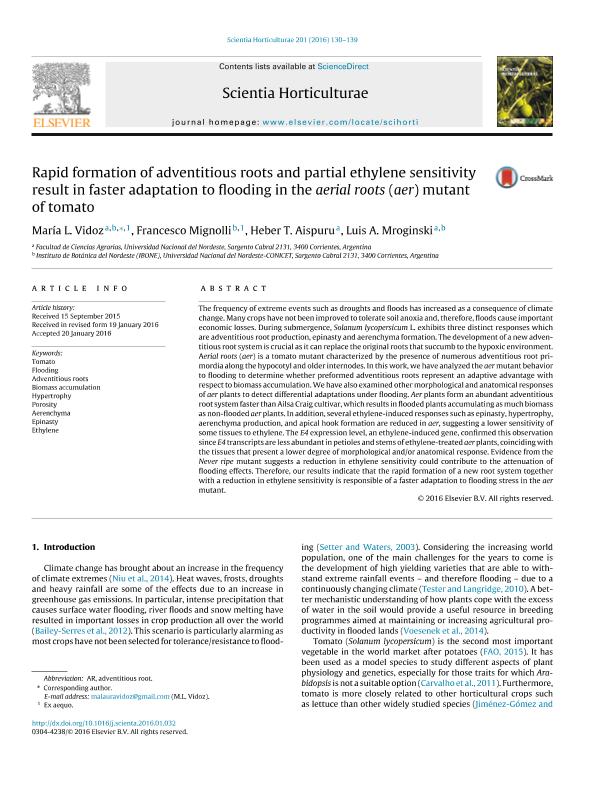Mostrar el registro sencillo del ítem
dc.contributor.author
Vidoz, María Laura

dc.contributor.author
Mignolli, Francesco

dc.contributor.author
Aispuru, Heber T.

dc.contributor.author
Mroginski, Luis Amado

dc.date.available
2017-07-14T17:32:00Z
dc.date.issued
2016-03
dc.identifier.citation
Vidoz, María Laura; Mignolli, Francesco; Aispuru, Heber T.; Mroginski, Luis Amado; Rapid formation of adventitious roots and partial ethylene sensitivity result in faster adaptation to flooding in the aerial roots (aer) mutant of tomato; Elsevier Science; Scientia Horticulturae; 201; 3-2016; 130-139
dc.identifier.issn
0304-4238
dc.identifier.uri
http://hdl.handle.net/11336/20599
dc.description.abstract
The frequency of extreme events such as droughts and floods has increased as a consequence of climate change. Many crops have not been improved to tolerate soil anoxia and, therefore, floods cause important economic losses. During submergence, Solanum lycopersicum exhibits three distinct responses which are adventitious root production, epinasty and aerenchyma formation. The development of a new adventitious root system is crucial as it can replace the original roots that succumb to the hypoxic environment. Aerial roots (aer) is a tomato mutant characterized by the presence of numerous adventitious root primordia along the hypocotyl and older internodes. In this work, we have analyzed the aer mutant behavior to flooding to determine whether preformed adventitious roots represent an adaptive advantage with respect to biomass accumulation. We have also examined other morphological and anatomical responses of aer plants to determine differential adaptations under flooding. Aer plants form an abundant adventitious root system faster than AC, which results in flooded plants accumulating as much biomass as non-flooded aer plants. It appears that, several ethylene-induced responses such as epinasty, hypertrophy, aerenchyma production, and apical hook formation are reduced in aer, suggesting a lower sensitivity of some tissues to ethylene. The E4 expression level, an ethylene-induced gene, confirmed this observation since E4 transcripts are less abundant in petioles and stems of ethylene-treated aer plants, coinciding with the tissues that presented a lower degree of morphological and/or anatomical response. Evidence from the Never ripe mutant suggests a reduction in ethylene sensitivity could contribute to the attenuation of flooding effects. Therefore, our results indicate that the rapid formation of a new root system together with a reduction in ethylene sensitivity is responsible of a faster adaptation to flooding stress in the aer mutant.
dc.format
application/pdf
dc.language.iso
eng
dc.publisher
Elsevier Science

dc.rights
info:eu-repo/semantics/openAccess
dc.rights.uri
https://creativecommons.org/licenses/by-nc-sa/2.5/ar/
dc.subject
Tomato
dc.subject
Flooding
dc.subject
Adventitious Roots
dc.subject
Biomass Accumulation
dc.subject
Hypertrophy
dc.subject
Porosity
dc.subject
Aerenchyma
dc.subject
Epinasty
dc.subject
Ethylene
dc.subject.classification
Otras Biotecnología Agropecuaria

dc.subject.classification
Biotecnología Agropecuaria

dc.subject.classification
CIENCIAS AGRÍCOLAS

dc.title
Rapid formation of adventitious roots and partial ethylene sensitivity result in faster adaptation to flooding in the aerial roots (aer) mutant of tomato
dc.type
info:eu-repo/semantics/article
dc.type
info:ar-repo/semantics/artículo
dc.type
info:eu-repo/semantics/publishedVersion
dc.date.updated
2017-06-08T19:47:22Z
dc.journal.volume
201
dc.journal.pagination
130-139
dc.journal.pais
Países Bajos

dc.journal.ciudad
Ámsterdam
dc.description.fil
Fil: Vidoz, María Laura. Universidad Nacional del Nordeste. Facultad de Ciencias Agrarias; Argentina. Consejo Nacional de Investigaciones Científicas y Técnicas. Centro Científico Tecnológico Conicet - Nordeste. Instituto de Botánica del Nordeste. Universidad Nacional del Nordeste. Facultad de Ciencias Agrarias. Instituto de Botánica del Nordeste; Argentina
dc.description.fil
Fil: Mignolli, Francesco. Consejo Nacional de Investigaciones Científicas y Técnicas. Centro Científico Tecnológico Conicet - Nordeste. Instituto de Botánica del Nordeste. Universidad Nacional del Nordeste. Facultad de Ciencias Agrarias. Instituto de Botánica del Nordeste; Argentina
dc.description.fil
Fil: Aispuru, Heber T.. Universidad Nacional del Nordeste. Facultad de Ciencias Agrarias; Argentina
dc.description.fil
Fil: Mroginski, Luis Amado. Universidad Nacional del Nordeste. Facultad de Ciencias Agrarias; Argentina. Consejo Nacional de Investigaciones Científicas y Técnicas. Centro Científico Tecnológico Conicet - Nordeste. Instituto de Botánica del Nordeste. Universidad Nacional del Nordeste. Facultad de Ciencias Agrarias. Instituto de Botánica del Nordeste; Argentina
dc.journal.title
Scientia Horticulturae

dc.relation.alternativeid
info:eu-repo/semantics/altIdentifier/url/http://www.sciencedirect.com/science/article/pii/S0304423816300334
dc.relation.alternativeid
info:eu-repo/semantics/altIdentifier/doi/http://dx.doi.org/10.1016/j.scienta.2016.01.032
Archivos asociados
